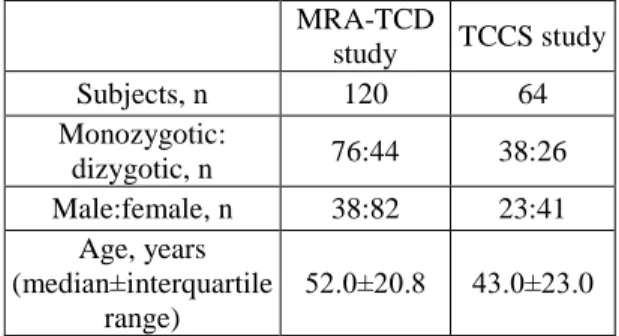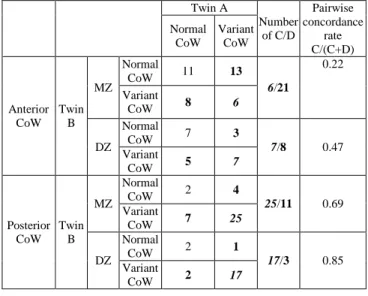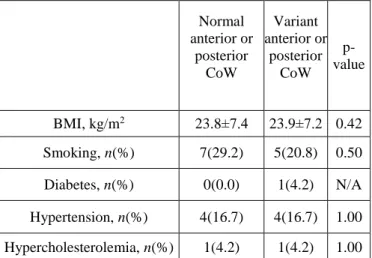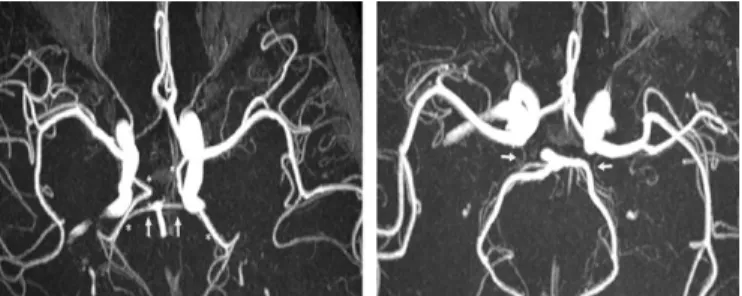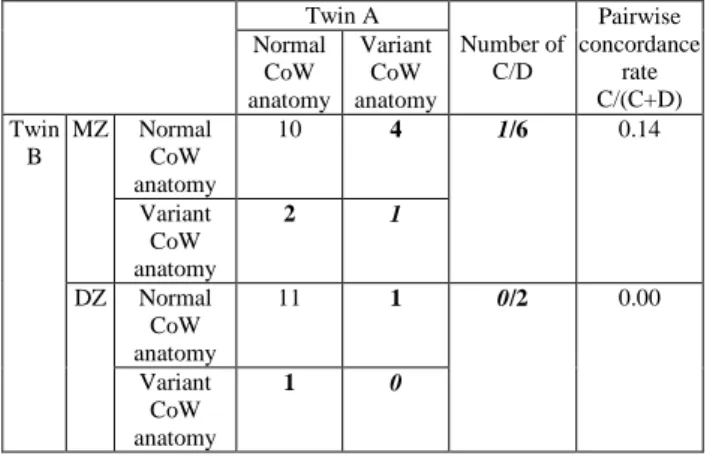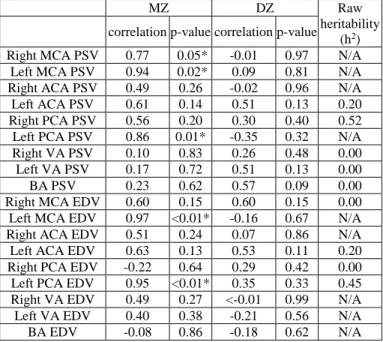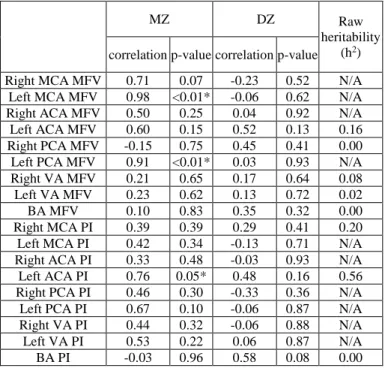GENETIC AND ENVIRONMENTAL EFFECTS ON THE MORPHOLOGY AND HEMODYNAMICS OF
THE CIRCLE OF WILLIS
PhD thesis
Bianka Forgó
Basic and Translational Medicine Doctoral School Semmelweis University
Supervisor: Ádám Domonkos Tárnoki, MD, Ph.D., med.habil.
Official reviewers: Dénes Horváthy, MD, Ph.D.
Arnold Tóth, MD, Ph.D.
Head of the Final Examination Committee:
Kálmán Hüttl, MD, Ph.D., med. habil.
Members of the Final Examination Committee:
Sándor Péter Manninger, MD, Ph.D.
Zsuzsanna Földes-Lénárd, MD, Ph.D.
Budapest 2019
2 1. Introduction
The circulus arteriosus cerebri, an arterial anastomotic polygon located at the skull base is of key importance regarding the maintenance of cerebral perfusion. The anastomotic circuit ensures blood supply to the brain through the cerebral and communicating arteries. The integrity of the Circle of Willis (CoW) seems to be crucial to maintain a compensatory flow in case of cerebrovascular events involving large cervical or cerebral artery stenosis or occlusion. However, the classical anatomical configuration of the CoW is rarely seen during autopsy and imaging studies. A relevant percentage of the healthy adult as well as paediatric population has hypoplasia or absence of one or more CoW arteries with variants being more common in the posterior circulation. The aetiology of these anatomical variants is unknown and the factors determining these variants are still to be elucidated. Vasculogenesis-related genes, stochastic (e.g. intrauterine) factors as well as ethnicity and haemodynamic factors may influence CoW flow and morphology, but the role of genetic and environmental factors behind these vascular phenotypes is not known.
The collateral flow in the CoW has been widely investigated in patients with internal carotid artery occlusion and stenosis, and intact collaterals seem to have key importance in maintaining cerebral perfusion in this patient group as the collaterals may compensate for the restricted flow in the stenotic vessel, which is the major artery ensuring cerebral blood supply. According to previous results, non-functional anterior and posterior collaterals had a higher prevalence in patients with anterior circulation stroke compared to patients with asymptomatic carotid artery disease and variations of the CoW were associated with greater risk of stroke in case of hypoplastic or absent segments of the CoW.
Digital subtraction angiography (DSA) is the gold standard imaging method of the CoW, but it is limited by its invasiveness, ionizing irradiation and the use of contrast media.
In routine diagnostic procedures, the morphology of the CoW
3
can be analysed by computer tomography angiography (CTA) and magnetic resonance angiography (MRA) with or without the administration of contrast media. However, the hemodynamic parameters of the CoW, such as peak systolic velocity (PSV), end-diastolic velocity (EDV), mean flow velocity (MFV), pulsatility index (PI) and resistance index (RI) can exclusively be measured real-time by transcranial insonation such as transcranial Doppler (TCD) or Transcranial Color Coded Duplex Sonography (TCCS).
2. Objectives
Although the importance of vascular variants is discussed and widely researched, their developmental background remains unclear. A number of stochastic and environmental factors might affect the formation of CoW variants. Thus, assessing the genetic versus environmental origin of CoW variants could also provide knowledge of genetic predispositions for offspring and could help to understand the role of modifiable environmental factors affecting CoW variants. It is possible through twin studies to assess whether heritability plays a significant role in the formation of the CoW variants or they are influenced mostly by other (environmental or stochastic) factors. Twin studies provide the ideal study model to assess the contribution of genetic versus environmental factors to a certain phenotype. The phenotypes we chose to investigate in the current study were the CoW-variants and the hemodynamic factors measured in the CoW. Heritability on the CoW morphology alone does not provide enough information, which is why we aimed to study both morphology and hemodynamics of the CoW in healthy individuals. Hypothetically, if the heritability of CoW variants in humans is high, then genetic factors have to be considered. In this case, positive family history could possibly be considered as a risk factor for offspring of individuals with CoW-variants, if our results are confirmed. On the contrary, if environmental factors dominate over genetics regarding CoW variants, then prevention should
4
be emphasized with focus on the relevant environmental factors that show an association with CoW variants.
Accordingly, the aim of our study was to analyse the impact of environmental and genetic factors on CoW morphology and hemodynamics in Caucasian twin samples assessed by MRA, TCD and TCCS.
3. Subjects and Methods 3.1. Subjects
Two independent samples were involved to investigate the morphology and hemodynamics of the CoW variants and their genetic and environmental background. Our first study population consisted of healthy Caucasian twins who are members of the Hungarian Twin Registry. 120 Hungarian twins attended the study (60 pairs), of whom 38 pairs were monozygotic (MZ) and 22 were dizygotic (DZ). These twin pairs underwent MRA and TCD studies. 64 Italian twins (32 twin pairs), 19 MZ and 13 DZ pairs were involved in the second study who underwent TCCS. Table 1 shows the characteristics of the two study populations.
Table 1. Characteristics of the twin study populations. MRA:
magnetic resonance angiography, TCCS: transcranial color- coded duplex sonography, TCD: transcranial Doppler.
MRA-TCD
study TCCS study
Subjects, n 120 64
Monozygotic:
dizygotic, n 76:44 38:26 Male:female, n 38:82 23:41
Age, years (median±interquartile
range)
52.0±20.8 43.0±23.0
5 3.2. Study design
3.2.1. Design of the MRA and TCD study
The investigation was approved by the regional ethical committees. All participating Hungarian twins signed an informed consent. The tenets of the Declaration of Helsinki were followed. Detailed history and risk factors were obtained by a questionnaire, collecting data on body weight and height, body mass index (BMI), smoking, hypertension, diabetes mellitus and hypercholesterolemia.
The twins underwent 3D time of flight magnetic resonance angiography (TOF MRA) of the cerebral arteries if the study was not contraindicated. Patients were excluded with any of the following conditions: pregnancy or positive pregnancy test, breast-feeding, immunosuppressive or immunomodulant therapy including systemic steroids in the past 30 days, chemotherapy within 1 year, major surgery within 2 months, transfusion or blood products received within 2 months.
Moreover, pacemaker, implantable cardioverter-defibrillator or other implanted devices, magnetic metal foreign bodies, claustrophobia and aphasia were regarded as exclusion criteria.
TOF MRA was obtained on the cranial vessels. No contrast media was applied. The 3D multi-slab TOF MRAs were reconstructed using maximal intensity projection (MIP).
Measurements were performed on a Siemens Magnetom Verio 3 Tesla scanner (Siemens Healthcare GmbH, Erlangen, Germany) at the first study location (Borsod-Abaúj-Zemplén County University Teaching Hospital) and they were performed on a Philips Ingenia 3 Tesla scanner (Philips Healthcare, Best, The Netherlands) at the second study location (MR Research Centre, Semmelweis University). Evaluation of the CoW was made both on MIP and multi-slice MR images by a single observer.
6
3.2.1.1. Evaluation of the TOF-MRA studies
We analysed each vessel of the CoW and determined if they were non-hypoplastic, hypoplastic or absent. Vessel diameters were measured on transverse slices of the 3D multi-slab TOF MR-angiograms. Non-visible vessels were defined as absent.
Visible arteries with a diameter under 0.8 mm were defined as hypoplastic. We categorized the anterior and posterior CoW variants separately according to their appearance.
3.2.1.2. Hemodynamic assessment using TCD
TCD was performed on the Hungarian twins (Multi-Dop T, Compumedics Germany GmbH, Singen, Germany) with a 2 MHz transducer. Through the transtemporal and transforaminal windows, MFV and PI were recorded bilaterally from the M1 segment of the middle cerebral artery (MCA), the anterior cerebral artery (ACA) A1 segment, P1 segment of the posterior cerebral artery (PCA) and the basilar artery (BA).
3.2.2. Design of the TCCS study
The TCCS investigations were conducted at the Neurosonological Laboratory of the University of Padua in 2014 on Italian twins. All study subjects underwent TCCS and a personal interview. Exclusion criteria were pregnancy, acute infectious disease, history of neurosurgical intervention and twin pairs dysgenesis. Prior to the examination, each participant signed an informed consent, after having been verbally informed about the course and purpose of the study.
During the research, the principles of the Helsinki Declaration were followed. For each subject, a complete history was obtained, body height and body weight were recorded, and BMI was calculated. Furthermore, systolic blood pressure (SBP) and diastolic blood pressure (DBP) was obtained and pulse pressure (PP) and mean arterial pressure (MAP) was calculated.
7
3.2.2.1. Hemodynamic assessment using TCCS
TCCS was performed always by the same investigator with the same ultrasound system (Toshiba Aplio XG) with a 2-4 MHz transducer (transducer type: PLT-30BT). Through the transtemporal and transforaminal windows, PSV as well as EDV were recorded on the M1 segment of the MCA, the A1 segment of the ACA, P1, P2a and P2p segments of the PCA, BA and the V4 segment of the vertebral artery (VA). The MFV and PI were calculated from the PSV and EDV values.
Anatomical variations of the CoW were recorded.
3.3. Statistical analysis
IBM SPSS Statistics for Windows, version 23 (IBM Corp., Armonk, N.Y., USA) and Microsoft Excel 2016 was used for all statistical analysis.
3.3.1. MZ-DZ comparison of continuous parameters and comparison of the measured TCCS hemodynamic parameters between men and women
We tested whether the variables fulfil the assumptions of the independent-samples t-test in both the MRA-TCD and the TCCS study. If the data showed non-normal distribution in both groups, then transformation of the data was performed. If the transformed data showed normal distribution on histograms and non-significant p-values of the Shapiro-Wilk test, then the homogeneity of variance was tested using Fisher’s F-test. If the homogeneity of variances assumption was not violated, then independent samples t-test was performed. We used Welch-test to compare means between two groups with normal distribution but significantly different variances.
If the assumption of normal distribution remained violated after data transformation, then we compared the MZ-DZ and men-women groups regarding the continuous variable using the non-parametric Mann-Whitney U-test.
8 3.3.2. Dichotomous variables
Fisher’s exact test was applied to investigate differences between MZ and DZ twins regarding sex, smoking, diabetes mellitus, hypertension and hypercholesterolemia in the MRA- TCD study as well as the difference between the MZ and DZ groups regarding sex in the TCCS study.
3.3.3. Correlations of the TCCS parameters
Correlations between the TCCS parameters and age, BMI, SBP, DBP and PP were obtained. If both correlated variables showed normal distribution, then Pearson’s correlation was conducted. In all other cases we used Spearman’s correlation.
3.3.4. Heritability and concordance rates
Twin studies aim to determine the genetic and environmental basis of a certain phenotypic variance. The concept of twin studies is based on the assumption that MZ twins share on average 100% of their genes, whereas DZ twins share 50% of their genes similarly to non-twin siblings. The similarity between co-twins is estimated with the concordance rate in case of categorical variables (which were used in the current study for CoW variants). Raw heritability is based on the comparison of within-pair correlations in MZ and DZ twins and it gives a rough estimation on the additive genetic effects on the trait if the sample size does not allow more complex heritability analysis (ACE univariant modelling). Raw heritability was calculated for the continuous TCCS variables.
We determined the concordance rates of anterior and posterior CoW morphology separately in the MRA-TCD study and for the whole CoW in the TCCS study. Pairwise concordance rates were estimated by the following formula:
𝑛 𝑐𝑜𝑛𝑐𝑜𝑟𝑑𝑎𝑛𝑡 𝑡𝑤𝑖𝑛 𝑝𝑎𝑖𝑟𝑠
𝑛 𝑐𝑜𝑛𝑐𝑜𝑟𝑑𝑎𝑛𝑡 𝑡𝑤𝑖𝑛 𝑝𝑎𝑖𝑟𝑠 + 𝑛 𝑑𝑖𝑠𝑐𝑜𝑟𝑑𝑎𝑛𝑡 𝑡𝑤𝑖𝑛 𝑝𝑎𝑖𝑟𝑠
9
We also investigated the raw heritability of the continuous hemodynamic parameters measured in TCCS tests, which was determined based on MZ and DZ within-pair correlations with the following formula:
2×(rMZ-rDZ)
3.3.5. Statistical analysis in MZ discordant twins in the MRA- TCD study
We examined the intra-pair differences regarding cardiovascular risk factors as well as TCD parameters in MZ twins discordant to anterior or posterior CW variants. Paired t- test was used regarding the majority of TCD parameters. Some hemodynamic parameters were not normally distributed and remained non-normally distributed after transformation. Non- parametric Wilcoxon-signed rank test was performed on these parameters. Dichotomous variables were compared within the MZ discordant twin pairs using McNemar’s test.
4. Results
4.1. Clinical characteristics
4.1.1. MRA and TCD study in Hungarian twins
The median age was 49.5 and 55.0 years in the MZ and DZ group, respectively. There was no significant difference regarding age, sex, smoking, diabetes and hypertension between the two groups, however, a significant difference was observed regarding BMI (p=0.01) and hypercholesterolemia (p=0.01).
4.1.2. TCCS study in Italian twins
The median age was 43.0 years in both the MZ and the DZ twins. There was no significant difference between MZ and DZ twins in terms of age, sex, SBP, DBP, PP and MAP, but there was a significant difference in BMI across zygosity (p=0.01).
10 4.2. Results of the MRA and TCD study 4.2.1. The prevalence of CoW variants
The most common anterior CoW configuration was the
“normal” form of the CoW without hypoplasticity or absence in the ACA and anterior communicating artery (ACoA) (45.0%), followed by hypoplastic ACoA (25.8%) and absent ACoA (10.8%). Bilaterally absent posterior communicating artery (PCoA) (22.5%) was the most commonly observed variant among posterior CoW configurations. Normal morphology (16.7%), bilaterally hypoplastic PCoA (15.0%) and unilaterally hypoplastic PCoA (11.7%) were also among the most common configurations in the posterior CoW.
Unilateral fetal configuration was seen in 10.9%. No significant difference was observed regarding anterior and posterior CoW variants between the MZ and DZ groups with one exception: bilaterally hypoplastic PCoA appeared in a significantly higher rate in the DZ group (p=0.02).
4.2.2. Concordance rates and TCD results
Table 2 shows the concordance rates of the anterior and posterior CoW variants according to the morphological classification. MZ concordance was not higher than DZ concordance in anterior and posterior variants suggesting the dominance of environmental factors on CoW configurations.
Figure 1 and 2 shows MRA images of a MZ discordant twin pair.
11
Table 2. Concordance rates of the anterior and posterior morphology of the CoW. C: concordant twin pairs, CoW:
Circle of Willis, D: discordant twin pairs, DZ: dizygotic, MZ:
monozygotic.
Twin A
Number of C/D
Pairwise concordance
rate C/(C+D) Normal
CoW
Variant CoW
Anterior CoW
Twin B
MZ Normal
CoW 11 13
6/21
0.22
Variant
CoW 8 6
DZ Normal
CoW 7 3
7/8 0.47 Variant
CoW 5 7
Posterior CoW
Twin B
MZ Normal
CoW 2 4
25/11 0.69 Variant
CoW 7 25
DZ Normal
CoW 2 1
17/3 0.85 Variant
CoW 2 17
4.2.3. Cardiovascular risk factors and intracerebral hemodynamic parameters in MZ twins discordant for CoW morphology
Out of our MZ twin group, 24 twin pairs were discordant regarding anterior or posterior CoW variants. Smoking, hypertension and hypercholesterolemia did not differ significantly between MZ discordant twins with variant and classical CoW configuration (Table 3). Flow parameters, such as MFV and PI did not show a significant difference in any segment of the CoW within MZ discordant twin pairs.
12
Table 3. Discordant monozygotic twins: intrapair comparison of cardiovascular risk factors in twins with and without CoW variants. BMI: body mass index, CoW: Circle of Willis, N/A:
not applicable.
Normal anterior or
posterior CoW
Variant anterior or
posterior CoW
p- value
BMI, kg/m2 23.8±7.4 23.9±7.2 0.42 Smoking, n(%) 7(29.2) 5(20.8) 0.50 Diabetes, n(%) 0(0.0) 1(4.2) N/A Hypertension, n(%) 4(16.7) 4(16.7) 1.00 Hypercholesterolemia, n(%) 1(4.2) 1(4.2) 1.00
Figure 1. Differences in anterior CoW variants of a monozygotic twin pair. Twin A has hypoplastic ACA A1
segment on the right side (arrow). Twin B has normal anterior CoW configuration. ACA: anterior cerebral artery, CoW: Circle of Willis (image from Department of
Radiology, Borsod-Abaúj-Zemplén County University Hospital).
13 4.3. Results of the TCCS study
4.3.1. Hemodynamic parameters in MZ and DZ twins
In case of the right MCA PSV, significant difference was found between the two groups (p=0.04), while there were no significant differences in the other vessels with regard to PSV, MFV, EDV and PI between MZ and DZ groups.
4.3.2. Haemodynamic parameters in relation to gender Significant difference was observed between men and women regarding the PI measured in the right ACA (p=0.01) and the left and right VAs (p=0.02 and p=0.03, respectively): higher PI
Figure 2. Differences in posterior CoW variants in a monozygotic twin pair. Twin A has bilateral fetal configuration (asterisk is in the left image) with absent PCA P1 segments on both sides. The arrows in the left picture point to the superior cerebellar arteries. Twin B
has bilaterally absent PCoAs. The arrows in the right picture show the anterior choroidal arteries. CoW:
Circle of Willis, PCA: posterior cerebral artery, PCoA:
posterior communicating artery (image from Department of Radiology, Borsod-Abaúj-Zemplén County University
Hospital.
14
was observed in women in these cases. The difference regarding PI, PSV, EDV, and MFV of the remaining vessels was not significant between men and women.
4.3.3. Hemodynamic parameters in relation to age, BMI and blood pressure
There was a significant inverse correlation between age and PSV and EDV for all vessels examined except for the right and left PCA. Similar associations were found regarding age and MFV, with two exceptions: the right ACA MFV and the right PCA MFV showed a non-significant association with age.
Correlation between age and PI was significant in case of the right MCA (p=0.03), right VA (p=0.05) and BA (p=0.03). The BMI also showed an inverse correlation with the TCCS parameters and the association was significant in some variables. The SBP and the DBP showed inverse, non- significant correlation with most of the hemodynamic parameters measured in the CoW, except for the correlations between the SBP and the PI where the correlation was positive.
PP was inversely associated with PSV, EDV and MFV values, whereas the correlation was positive between the PP and the PI values. Inverse correlation was found between the TCCS traits and MAP values, however, it was non-significant in the majority of parameters.
4.3.4. Concordance and discordance rates
Concordance rates regarding CW variants could be estimated in the total of 17 MZ twin pairs as two MZ twin pairs had to be excluded from this analysis due to bad acoustic window. A normal CoW anatomy was observed in most of the MZ and DZ twins (77% and 92%, respectively). Of the detectable CoW variants, the majority of individuals had an absent ACA, but this variant showed significant differences between MZ and DZ twins (p = 0.044). There was no significant difference in the other variations depending on the zygosity. Concerning the concordance of the MZ and DZ twins, the presence of
15
variations showed no genetic influence as MZ concordance was not considerably higher (0.14) compared to DZ concordance (0.00). The concordance rates are shown in Table 4.
Table 4. The concordance rates of the detected variants in the MZ and DZ groups. C: concordant twin pairs, CoW: Circle of
Willis, D: discordant twin pairs, DZ: dizygotic, MZ:
monozygotic.
Twin A
Number of C/D
Pairwise concordance
rate C/(C+D) Normal
CoW anatomy
Variant CoW anatomy Twin
B
MZ Normal CoW anatomy
10 4 1/6 0.14
Variant CoW anatomy
2 1
DZ Normal CoW anatomy
11 1 0/2 0.00
Variant CoW anatomy
1 0
4.3.5. Intra-pair correlations of hemodynamic variants For most hemodynamic parameters, we found a low to moderate raw heritability. The highest heritability was found in left PCA EDV, right PCA PSV and left ACA PI (0.45, 0.52 and 0.56, respectively). Low heritability (0.00 to 0.20) was observed in the rest of the measured hemodynamic parameters, such as left ACA PSV, right and left VA PSV, BA PSV, right MCA EDV, left ACA EDV, right PCA EDV, left ACA MFV, right PCA MFV, right and left VA MFV, BA MFV, right MCA PI and BA PI. In the remaining hemodynamic parameters heritability could not be estimated. The raw heritability of hemodynamic parameters is shown in Table 5 and 6.
16
Table 5. Correlation of PSV and EDV values, their p-value and raw heritability. ACA: anterior cerebral artery, BA:
basilar artery, DZ: dizygotic, EDV: end diastolic velocity, MCA: middle cerebral artery, MZ: monozygotic, N/A: not applicable, PCA: posterior cerebral artery, PSV: peak systolic velocity, VA: vertebral artery. Significant p-values
are indicated by asterisk.
MZ DZ Raw
heritability (h2) correlation p-value correlation p-value Right MCA PSV 0.77 0.05* -0.01 0.97 N/A
Left MCA PSV 0.94 0.02* 0.09 0.81 N/A Right ACA PSV 0.49 0.26 -0.02 0.96 N/A Left ACA PSV 0.61 0.14 0.51 0.13 0.20 Right PCA PSV 0.56 0.20 0.30 0.40 0.52 Left PCA PSV 0.86 0.01* -0.35 0.32 N/A Right VA PSV 0.10 0.83 0.26 0.48 0.00 Left VA PSV 0.17 0.72 0.51 0.13 0.00
BA PSV 0.23 0.62 0.57 0.09 0.00
Right MCA EDV 0.60 0.15 0.60 0.15 0.00 Left MCA EDV 0.97 <0.01* -0.16 0.67 N/A Right ACA EDV 0.51 0.24 0.07 0.86 N/A Left ACA EDV 0.63 0.13 0.53 0.11 0.20 Right PCA EDV -0.22 0.64 0.29 0.42 0.00 Left PCA EDV 0.95 <0.01* 0.35 0.33 0.45 Right VA EDV 0.49 0.27 <-0.01 0.99 N/A Left VA EDV 0.40 0.38 -0.21 0.56 N/A BA EDV -0.08 0.86 -0.18 0.62 N/A
17
Table 6. Correlation of MFV and PI values, their p-value and raw heritability. ACA: anterior cerebral artery, BA: basilar
artery, DZ: dizygotic, MCA: middle cerebral artery, MFV:
mean flow velocity, MZ: monozygotic, N/A: not applicable, PCA: posterior cerebral artery, PI: pulsatility index, VA:
vertebral artery. Significant p-values are indicated by asterisk.
MZ DZ Raw
heritability (h2) correlation p-value correlation p-value Right MCA MFV 0.71 0.07 -0.23 0.52 N/A
Left MCA MFV 0.98 <0.01* -0.06 0.62 N/A Right ACA MFV 0.50 0.25 0.04 0.92 N/A Left ACA MFV 0.60 0.15 0.52 0.13 0.16 Right PCA MFV -0.15 0.75 0.45 0.41 0.00 Left PCA MFV 0.91 <0.01* 0.03 0.93 N/A Right VA MFV 0.21 0.65 0.17 0.64 0.08 Left VA MFV 0.23 0.62 0.13 0.72 0.02
BA MFV 0.10 0.83 0.35 0.32 0.00
Right MCA PI 0.39 0.39 0.29 0.41 0.20 Left MCA PI 0.42 0.34 -0.13 0.71 N/A Right ACA PI 0.33 0.48 -0.03 0.93 N/A Left ACA PI 0.76 0.05* 0.48 0.16 0.56 Right PCA PI 0.46 0.30 -0.33 0.36 N/A Left PCA PI 0.67 0.10 -0.06 0.87 N/A Right VA PI 0.44 0.32 -0.06 0.88 N/A Left VA PI 0.53 0.22 0.06 0.87 N/A
BA PI -0.03 0.96 0.58 0.08 0.00
5. Conclusion
Our study is the first to investigate genetic versus environmental background of the CoW variants with MRI and TCCS in frame of a twin study. Our results show that anatomical variants of the CoW, which commonly occur and
18
might predispose to cerebrovascular events, might be shaped and influenced by environmental or stochastic factors, however, our results do not allow to draw conclusions on heritability. In contrast, few intracranial hemodynamic parameters showed moderate raw heritability in our TCCS study, but the majority of these recorded parameters showed low heritability underlining the importance of environmental and/or stochastic factors. Anterior and posterior CoW variants were not associated with current BMI, smoking, hypertension and hypercholesterolemia and altered blood flow during TCD studies. Since increasing evidence supports that CoW variants are the risk factors of cerebrovascular ischaemia, determining their origin is essential to develop preventive strategies. Our results should stimulate further research on the origin of CoW variants on larger twin populations with the goal to determine heritability using detailed analysis (ACE-model). Further studies should be stimulated to elucidate which epigenetic and environmental factors are responsible for these variants, which might play a role in stroke prevention and management of patients with CoW variants.
6. Bibliography of own publications
6.1. Publications related to the current PhD thesis
Forgo B, Tarnoki AD, Tarnoki DL, Kovacs DT, Szalontai L, Persely A, Hernyes A, Szily M, Littvay L, Medda E, Szabo A, Kozak LR, Rudas G, Sas A, Sepsi M, Kostyal L, Olah C.
(2018) Are the Variants of the Circle of Willis Determined by Genetic or Environmental Factors? Results of a Twin Study and Review of the Literature. Twin Res Hum Genet, 21 (5):
384-393. (IF: 1.669)
19
Forgo B, Tarnoki AD, Tarnoki DL, Littvay L, Fagnani C, Stazi MA, Meneghetti G, Medda E, Farina F, Baracchini C.
(2018) Investigation of circle of Willis variants and hemodynamic parameters in twins using transcranial color- coded Doppler sonography. Int J Cardiovasc Imaging, 34 (9):
1419-1427. (IF: 2.036)
6.2. Publications not related to the current PhD thesis Bikov A, Kolossváry M, Jermendy AL, Drobni ZD, Tarnoki AD, Tarnoki DL, Forgó B, Kovacs DT, Losonczy G, Kunos L, Voros S, Merkely B, Maurovich-Horvat P. (2018) Comprehensive coronary plaque assessment in patients with obstructive sleep apnea. J Sleep Res, 6:e12828. (IF: 3.433)
Forgo B, Medda E, Hernyes A, Szalontai L, Tarnoki DL, Tarnoki AD. (2018) Carotid Artery Atherosclerosis: A Review on Heritability and Genetics. Twin Res Hum Genet, 21(5):333-346. (IF: 1.669)
Mihály Z, Banga P, Szatai L, Simonffy Á, Fontanini DM, Bélteki J, Forgó B, Szeberin Z. (2017) Tompa trauma okozta mellkasi aortasérülések endovascularis ellátása.
[Endovascular treatment of blunt thoracic aortic injuries].
Magy Seb, 70(1):13-17.
Kunos L, Lazar Z, Martinovszky F, Tarnoki AD, Tarnoki DL, Kovacs D, Forgo B, Horvath P, Losonczy G, Bikov A.
(2017) Overnight Changes in Lung Function of Obese Patients with Obstructive Sleep Apnoea. Lung, 195(1):127- 133. (IF: 2.101)
20
Tárnoki DL, Tárnoki ÁD, Kovács DT, Forgó
B, Martinovszky F, Gáll O, Littvay L, Losonczy G, Kunos L, Bikov A. (2016) Az alvás alatti légzészavarok hátterében álló örökletes tényezők: egy ikervizsgálat tapasztalatai. Med Thor, 69(2): 87-95.
Kovács H, Fehérvári M, Forgó B, Gősi G, Oláh Z, Csobay- Novák C, Entz L, Szeberin Z. (2014) Electiv infrarenalis aortaaneurysma sebészi kezelésének korai és késői mortalitása és morbiditása. [Early and late mortality and morbidity after elective repair of infrarenal aortic aneurysm].
Magy Seb, 67(5):297-303.
